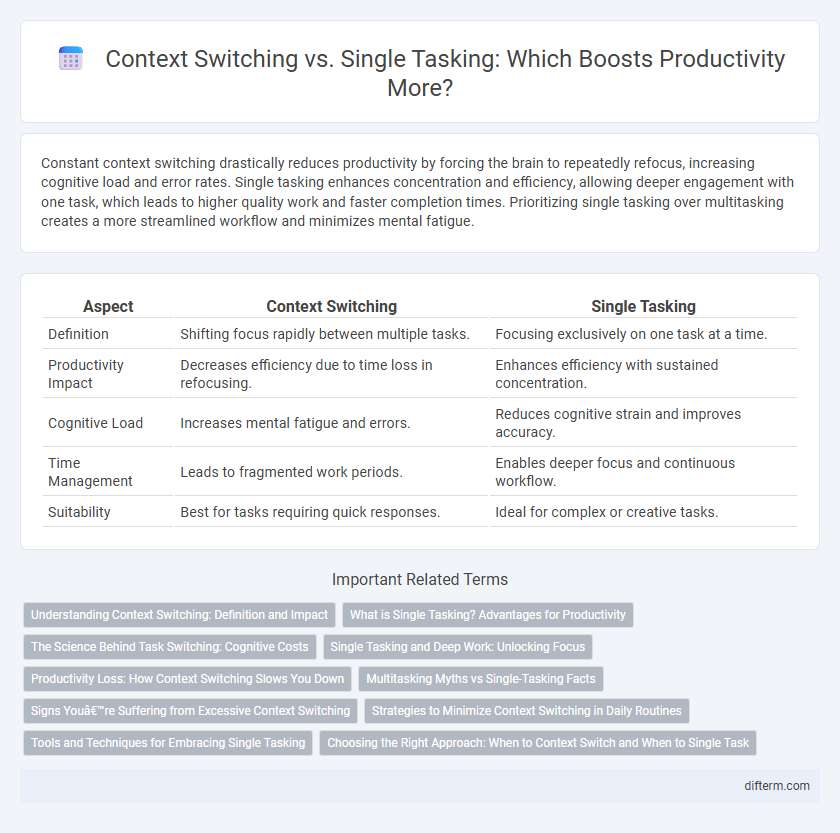Constant context switching drastically reduces productivity by forcing the brain to repeatedly refocus, increasing cognitive load and error rates. Single tasking enhances concentration and efficiency, allowing deeper engagement with one task, which leads to higher quality work and faster completion times. Prioritizing single tasking over multitasking creates a more streamlined workflow and minimizes mental fatigue.
Table of Comparison
| Aspect | Context Switching | Single Tasking |
|---|---|---|
| Definition | Shifting focus rapidly between multiple tasks. | Focusing exclusively on one task at a time. |
| Productivity Impact | Decreases efficiency due to time loss in refocusing. | Enhances efficiency with sustained concentration. |
| Cognitive Load | Increases mental fatigue and errors. | Reduces cognitive strain and improves accuracy. |
| Time Management | Leads to fragmented work periods. | Enables deeper focus and continuous workflow. |
| Suitability | Best for tasks requiring quick responses. | Ideal for complex or creative tasks. |
Understanding Context Switching: Definition and Impact
Context switching refers to the process of shifting attention from one task to another, which interrupts cognitive flow and increases mental fatigue. Studies show that frequent context switching can reduce productivity by up to 40% due to lost time in refocusing and reorienting to new tasks. Understanding this impact highlights the efficiency benefits of single-tasking, where sustained focus leads to higher quality work and faster completion times.
What is Single Tasking? Advantages for Productivity
Single tasking involves dedicating full attention to one task at a time, minimizing distractions and interruptions that typically occur during context switching. This focused approach enhances cognitive efficiency, reduces errors, and accelerates task completion, thereby boosting overall productivity. Studies show that single tasking can improve work quality by up to 50% compared to multitasking or frequent context switching.
The Science Behind Task Switching: Cognitive Costs
Task switching significantly impairs productivity due to the brain's limited executive control capacity, resulting in cognitive costs such as increased error rates and longer completion times. Neuroscientific studies reveal that shifting attention between tasks triggers activation in the anterior cingulate cortex and prefrontal cortex, areas responsible for managing conflicting information and reorienting focus. Single-tasking minimizes these neural demands, enabling deeper concentration and more efficient information processing.
Single Tasking and Deep Work: Unlocking Focus
Single tasking enhances productivity by minimizing cognitive load and reducing errors, enabling deeper concentration on one task at a time. Deep work leverages this focused attention to achieve higher quality outcomes and faster completion of complex tasks. Prioritizing single tasking over context switching cultivates sustained mental clarity and maximizes intellectual output.
Productivity Loss: How Context Switching Slows You Down
Context switching significantly impairs productivity by increasing cognitive load and wasting time as the brain refocuses on new tasks. Studies show that frequent task switching can reduce efficiency by up to 40%, leading to longer completion times and more errors. Single-tasking enhances focus and performance by allowing deeper concentration, resulting in higher quality work and faster task completion.
Multitasking Myths vs Single-Tasking Facts
Multitasking often leads to decreased productivity due to frequent context switching, which fragments attention and increases cognitive load. Research shows single-tasking improves focus and efficiency by allowing deeper engagement with one task at a time, reducing error rates and completion times. Fact-based studies reveal that the brain performs optimally when concentrating on a single objective, debunking the myth that multitasking enhances output.
Signs You’re Suffering from Excessive Context Switching
Frequent task interruptions, scattered attention, and decreased work quality are clear signs you're suffering from excessive context switching. Struggling to complete tasks on time and feeling mentally exhausted indicate the cognitive load caused by shifting focus between multiple activities. Monitoring reduced productivity and increased error rates helps identify when context switching disrupts effective single-tasking efforts.
Strategies to Minimize Context Switching in Daily Routines
Implementing designated time blocks for specific tasks reduces context switching and enhances focus by minimizing distractions. Utilizing tools like task lists and priority matrices streamlines workflow, allowing for deeper cognitive engagement with single tasks. Establishing clear boundaries and minimizing multitasking environments empowers sustained productivity and improved work quality.
Tools and Techniques for Embracing Single Tasking
Leveraging tools like time-blocking apps and website blockers enhances focus by minimizing context switching interruptions. Techniques such as the Pomodoro method and deep work intervals help maintain sustained attention on one task, improving productivity and cognitive performance. Utilizing task management software to prioritize and sequence tasks supports a more effective single-tasking workflow.
Choosing the Right Approach: When to Context Switch and When to Single Task
Context switching demands cognitive effort that often reduces productivity, making single tasking ideal for complex or creative work requiring deep focus. Tasks with natural breaks or lower cognitive load benefit from context switching, allowing flexibility and efficient use of downtime. Evaluating task complexity and mental energy levels guides choosing between single tasking for sustained concentration and context switching for varied, less demanding activities.
Context switching vs Single tasking Infographic

 difterm.com
difterm.com